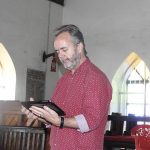The book of Ruth is for many reasons a beautiful book. It’s a story about great loyalty and commitment, of dedication and selflessness and devotion, a compassionate love story but of course above all it appears to be written specifically for the nation Israel so that they could see the lineage of David as coming through Ruth and Boaz.
However there is even yet a deeper spiritual significance within this story.
Not only does it point out the Davidic lineage as through Boaz but points to the fact that God always intended that the blessing He had covenanted to the Jews (Boaz) would also be offered to the Gentiles (Ruth). It was always to be for both Jew and Gentile since He purposed even then that one day the ‘two would become one’ in the One New Man.
The Messiah would be “a light to lighten the Gentiles AND My people Israel”.
This story is about that One New Man too.
Brief Background
The Book of Ruth’s author is never mentioned but it was not written by Ruth. Some Bible scholars believe it was written by Samuel but years before David became king as it refers to a “former time” so the date may have been around 1010 B.C. and appears to be an account that took place during the time of the judges. It appears to be written specifically for the nation Israel so that they could see the lineage of David as coming through Ruth and Boaz.
Famine and Death
Elimelech and Naomi are an Israelite influential family from Bethlehem.
When famine struck the area, they were forced to migrate to Moab which was a pagan nation and that was when Elimelech which means ‘My God is King’. died. His death was very significant, for the death of ‘My God is King’ was a description of the state of Israel at this time and their experience of God.
It would appear that life for Naomi was not good in Moab either as she names her two sons Mahlon and Chilion which means ‘ Invalid’ and ‘Pining’ respectively. These two sons married Moabite women, Orpah and Ruth who were Moabite princesses, daughters of King Elgon and granddaughters of King Balak of Moses time.
But both of Naomi’s sons died too so it was only Naomi and her two daughters remaining. This was a great misfortune for the family because they had no source of income and unlike Israel, Moab had no such support system for widows and orphans.
Naomi meant ‘full or pleasant’ but she now calls herself Mara which means ‘bitter’ and the only thing that Naomi can do is to find one of her
Naomi
Orpah remained in Moab and remarried and bore Goliath the giant whom King David slew.
But things were about to change, for Ruth, which means ’friend’, is about to be greatly blessed
Naomi located Boaz, one of the next of kin of her late husband. Boaz means “my strength” and ‘Lord of the Harvest’ and after
Boaz saw Ruth in the fields gleaning grain and inquired about who she was (2 v 5). They told Boaz that it was a Moabite woman that came with the widow Naomi from out of Moab. (2 v 6). Boaz made her feel welcome and invited her to stay in the area and
The Kinsman Redeemer
Naomi suggested that it would be best for Ruth to be redeemed by Boaz and to marry him. He would become her
Notice, it was a Jewess called Naomi who introduced the Gentile Ruth to the Redeemer, her future Bridegroom King. (“a light to lighten the Gentiles”)
It was also the Jewish disciples and apostles who first shared the gospel with we Gentiles. It was their scriptures that brought us such revelation.
We have so much to be grateful to them for.
So Ruth embraced the Jewish traditions and went and washed
When Boaz had finished his evening meal, he lay down and Ruth uncovered his feet and lay next to them and Boaz was startled and
Ruth said “I am Ruth your handmaid. Please spread your skirt over your handmaiden, for you are a near kinsman” (3 v 9).
Boaz accepted Ruth graciously and
He had heard how she had shown kindness to Naomi her mother in law.
Ruth is a type of the Bride of Christ and demonstrates so beautifully one of the most endearing characteristics of the Bride, that of grace.
“And now, my daughter, don’t fear. I will do to you all that you require, for all the city of my people know that you are a virtuous woman. For it has come to my notice how you have taken care of your mother-in-law. And now it is true that I am your near kinsman.”
However, there is a kinsman nearer than I” (3 v 10-12).
We too as believers had another kingsman to whom we were once legally bound and who because of our own sin and foolishness had gained legal right over us. Satan Himself.
But our true Kingsman Redeemer paid the price for our ransom and redemption. Jesus by His blood won back the right to own us, to love us, and to cover us with His garments’….. the corner of His skirt was spread over us too.
Satan is no match for our Jesus. In the story here, when the other kinsman, who had the legal ownership finds out that Ruth and Naomi had no inheritance, he declined to take her as his wife and so she was free to be married to Boaz and so Boaz became her ‘
Boaz then went even further and bought all that Elimelech had and Boaz and Ruth ended getting married and Ruth and Boaz became part of the royal lineage that would extend down to David and hundreds of years later, the lineage of Jesus Christ.
Interestingly not everyone can be a Kingsman Redeemer.
There are four special qualifications.
0. They have to have the legal right to redeem.
0. They have to be willing to redeem.
0. They have in addition to
0. They have to be willing to avenge the enemies of the redeemed or protect the redeemed against any future claims from their adversaries.
0. And there has to be a legal transaction made in the presence of witnesses.
This was so in the case of Boaz. He qualified in all these areas.
And so did the Lord Jesus for us. He is our Kingsman Redeemer.
0. Jesus won the legal right over us by the shedding of His blood.
0. Jesus is willing to redeem. “The Son of Man, the Good Shepherd lays down His life for the sheep” John. Scripture makes it clear in Philippians 2 that Jesus humbled Himself willingly and became obedient unto death even the death of the cross”
0. Jesus paid the redemption price. “We are purchased with His blood” Peter
0. Jesus has and will continually avenge all our enemies. He is the heavenly advocate and for ever pleads our case before the throne.
0. And finally, the transaction Jesus made for us on the cross was ratified in public and before Satan and witnessed by all of heaven.
There are so many spiritual lessons in broader general terms too that we can glean from the book of Ruth.
For example:
• Christians are like Ruth, a Moabite, or specifically, Gentiles but God offers salvation, first to the Jews but also to the Gentiles also (Rom 1 v 16; 2 v 10).
• Just as Boaz sought after Ruth, and took a deep interest in her, so God sought us (2 v 6-14).
• When Ruth bowed down at Boaz’ feet as her Lord , so we bow down and submit at Christ’s feet (2 v 10) and as Ruth humbled herself before Boaz, (3 v 4) we must humble ourselves before Christ (1 Pet 5 v 6; James 4 v 10).
• And God ensures that we will have all of our needs met like Boaz made sure Ruth would have all that she needed (2 v 7-16). She was allowed to collect even that which Boaz had instructed his men to leave.
• Boaz gave Ruth comfort (2 v 13) just as God comforts us (2 Cor 1).
• Just as we have all of our sins washed away and have the righteousness of Christ imputed to us (2 Cor 5:21) so Ruth washed herself and put on her best apparel (Ruth 3 v 3) representing our white linen mentioned in Revelation 19 v 9 and our “robes and garments of righteousness”.
• And Christians have had their sinfulness covered by Christ’s righteousness; Boaz gave Ruth the vail that she was covered with that had been used by Boaz (3 v 14-15).
However, the key reason for this beautiful book being included in the cannon of scripture, at least in the mind and heart of the Father, is revealed only towards the end of the story.
The keys word here is RECONCILIATION and ONENESS.
Notice that to enter into their full blessing both Naomi (Jew) and Ruth (Gentile) had to return to Bethlehem. Ruth 2 v 5?
Bethlehem means ‘House of Bread’.
And they needed to come 1) to where the Bread of Life was. Jesus is the Bread of Life, the “mana that comes down out of heaven”. And 2) they needed to both come.
This is the time for both the Jews and Gentiles to return to Bethlehem together… to the House of Bread. There is a blessing there that awaits them both.
Notice that these blessings and the covenant conditions they enjoyed of a Kingsman Redeemer, were first given to Naiomi (the Jews) and then extended toward the Ruth (the Gentiles).
Yeshuah Himself was first the Jewish redeemer, “the glory of My people Israel” and then, only then …..”a lighten to lighten the Gentiles”.
The Gentile Bride can only fully enter her destiny if the Jewish Bride enters hers for the two are part of the one.
The book of Ruth is about reconciliation and restoration of Naomi (Israel). …about reconciling Naomi (Israel) to Boaz (the Messiah, her Kingsman Redeemer)
And Ruth (the Gentiles) to Naomi (the Jews) and bringing both to Bethlehem and the Bread of Life (Yeshuah).
It is about that which God is creating even in these days and revealing to the world. It is about the Bride, yes, but not just a Gentile Bride or a Jewish Bride but a ‘One New Creation’ Bride.
She will be an amazing glorious new creation made up of Jew and gentile yet neither Jew nor Gentile, a glorious creation at the sight of whom all of nature will marvel and rejoice for it has been…” eagerly awaiting these sons of God to be made manifest”.
Ruth the Gentile was blessed because she “looked after her Jewish mother-in-law.
Ruth the gentile looked after Naomi and was blessed.
And Boaz saw it. The ‘Lord of the Harvest’ saw it…… and blessed them for it!
Jesus too is the Lord of the Harvest. He sees and takes notice when the Gentiles Church begins to serve and care for her Jewish brothers and sisters, prayers for them, serves them. Then the Lord sees it…..and blesses.
We must pray for Israel and for Jerusalem and the salvation of His people for……
“I will bless those who bless you (Israel) and curse those who curse you”
Because of Ruth’s (the Gentile) generosity toward Naomi (the Jewess) God blessed Ruth not only with marriage but with a son. And Ruth not only blessed Naomi but restored her too in a way she could only of dreamed of
In Ruth 11 verse 13 Boaz took Ruth as his wife and she bore Obed. But the fruit of this relationship also brought restoration for Naomi (Israel)
Obed means ‘service, usefulness, fulfilment’
And how was Naomi blessed by the birth of Obed? Of course Ruth was blessed as the birth mother …. but Naomi was greatly blessed because scripture records in Ruth that all the people said of Naomi on that day….
“the Lord has not left you this day. May He (Yeshuah) be to you Naomi (Israel) the restorer of life through Ruth (the Gentiles)”.
How did this happen?
Naomi in her old age took Obed (service) as her child and raised him as her own and even her neighbours (the sons of Ishmael, the Arabs) said….”A child has been born to Naomi”.
In the restoration of Naomi we see a picture of the restoration of Israel.
In the return of Naomi, the Jewish people, to the Lord and their acceptance of Yeshuah, the Bread of Life, as their Messiah, together with the Gentiles, we will see the restoration of Israel and this will enable the number and make-up of the Bride to be complete and so begin to reveal the One New Man to the world.
Then the trumpet shall sound, the Lord of the Harvest, our Bridegroom King, will Himself return, the Wedding of the Lamb and the consummation of the Bride take place and ‘that woman’, hidden in heaven, yet seen in the stars but not made manifest, will be seen by all upon the earth.






